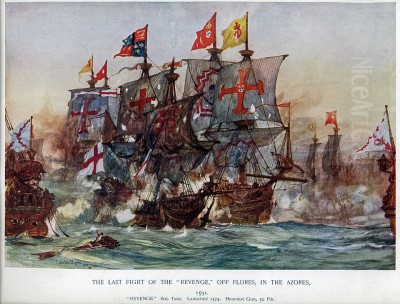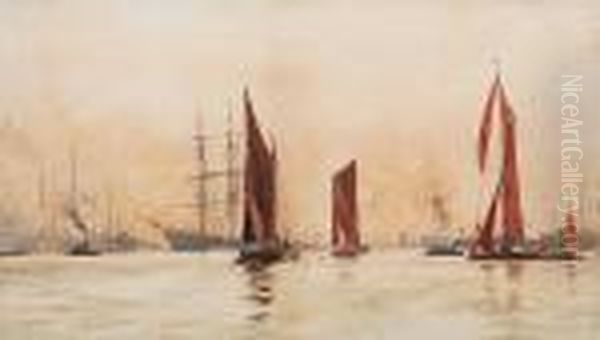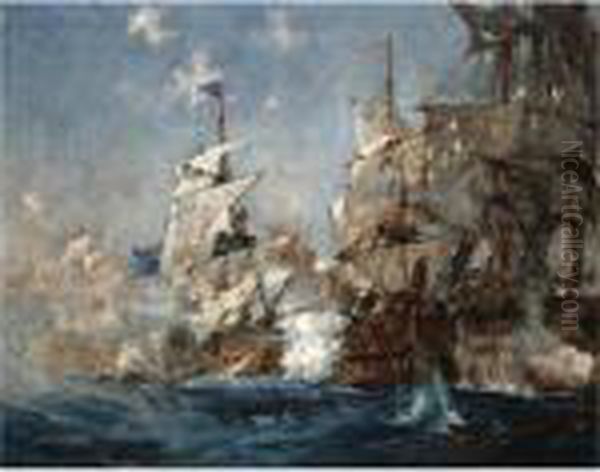
Charles Edward Dixon stands as a significant figure in the annals of British marine painting. Active during the late nineteenth and early twentieth centuries, a period of profound change in maritime technology and global power, Dixon dedicated his artistic career to capturing the lifeblood of the British Empire: its ships, its ports, and its relationship with the sea. Working primarily in watercolour, a medium he mastered with exceptional skill, Dixon produced a vast body of work celebrated for its accuracy, atmospheric quality, and evocative portrayal of naval power and commercial shipping. His art provides a vivid window into an era when Britain's identity was inextricably linked to its dominance of the waves.
Born in 1872, Dixon entered a world where the legacy of great British marine painters like J.M.W. Turner and Clarkson Stanfield was still profoundly felt. The sea was not merely a landscape element but a stage for national pride, economic might, and historical narrative. Dixon inherited this tradition, focusing his lens on the contemporary maritime world while occasionally dipping into historical subjects. His death in 1934 marked the end of a prolific career that saw his work widely exhibited and reproduced, reaching a broad audience appreciative of his detailed and spirited depictions of life afloat.
Early Development and Artistic Influences
While specific details of his early training remain somewhat scarce compared to artists who left extensive journals or correspondence, it is known that Charles Edward Dixon's father, Alfred Dixon, was also an artist. This familial connection likely provided an initial immersion in the world of art and perhaps fostered his inclination towards marine subjects, a popular and commercially viable genre in Victorian and Edwardian Britain. Growing up during a time of immense national pride centred on the Royal Navy and the vast merchant fleet, the visual spectacle of Britain's maritime power would have been inescapable.

Dixon developed his skills during a period where watercolour painting was held in high esteem in Britain, with prestigious bodies like the Royal Institute of Painters in Water Colours (RI), to which Dixon would later be elected, championing the medium. He honed a style characterized by meticulous draughtsmanship combined with a fluid, confident handling of washes to convey the challenging elements of water and sky. Unlike the dramatic, often turbulent seascapes of Turner, Dixon's work generally focused on the more tangible aspects of ships and harbours, emphasizing accuracy and detail, aligning him more closely with the tradition of maritime portraiture and topographical view painting.
His approach resonated with the public's fascination for the intricacies of ship design and the bustling activity of ports. While perhaps not an innovator on the scale of James McNeill Whistler, whose atmospheric Thames nocturnes pushed artistic boundaries, Dixon excelled within his chosen field. He absorbed the lessons of earlier marine specialists, adapting them to depict the specific vessels and environments of his own time with clarity and conviction. His commitment to watercolour allowed him to work with speed and brilliance, capturing fleeting effects of light and weather that are so crucial to maritime scenes.
Mastery of Watercolour and Technique
Charles Edward Dixon's reputation rests significantly on his exceptional command of the watercolour medium. Watercolour, often perceived as unforgiving, requires a deft hand and precise planning, as mistakes are difficult to correct. Dixon demonstrated a remarkable ability to manipulate transparent washes to create effects of light on water, the haze of a busy port, or the crisp lines of a ship's rigging against the sky. His palette was typically clear and bright, suitable for capturing sunny days on the water or the colourful flags and funnels of steamers.
His technique often involved a strong underlying drawing, ensuring the accuracy of the vessels he depicted. This attention to detail was crucial for a clientele that often included shipping companies, naval officers, and enthusiasts who valued correctness in the portrayal of specific ships. Over this precise drawing, Dixon would apply washes with confidence, layering colours to build depth and atmosphere without sacrificing luminosity. He was particularly adept at rendering the complex interplay of reflections on the water's surface and the subtle gradations of tone in the sky.

Compared to contemporaries like William Lionel Wyllie, who often employed a more tonal, almost monochromatic palette to capture the industrial atmosphere of the Thames, Dixon's work frequently exhibits a brighter, more illustrative quality. This is not to suggest a lack of atmosphere, but rather a different focus – often celebrating the grandeur and activity of shipping rather than its more melancholic or industrial aspects. His skill extended to incorporating figures – dockworkers, sailors, passengers – adding life and scale to his compositions, reminiscent of the detailed genre scenes found in some earlier marine art.
The Thames and the Port of London
The River Thames, particularly the bustling stretches through the Port of London, was a recurring and vital subject for Charles Edward Dixon, as it was for many artists before and during his time. This great waterway was the artery of the Empire, crowded with vessels of every description, from ocean liners and cargo steamers to tugboats, barges, and sailing ships. Dixon captured the dynamic energy of this environment in numerous works, documenting the changing face of the river as sail gradually gave way to steam and the docks expanded.
His paintings often depict well-known landmarks along the Thames – Tower Bridge, the Houses of Parliament, the Pool of London – but always with the focus firmly on the maritime activity. He recorded the specific character of different areas, from the Pool's dense concentration of shipping to the broader reaches downstream towards Tilbury, where larger vessels might be seen. His 1900 watercolour, Off Tilbury Docks, for instance, likely captures the scene in this busy part of the estuary, perhaps featuring a liner or large cargo ship characteristic of the period's trade.
In depicting the Thames, Dixon followed in the footsteps of artists like Canaletto (Giovanni Antonio Canal) in the 18th century, who recorded its earlier life, and contemporaries such as Wyllie, who perhaps captured its industrial moods more poetically. Dixon's contribution was his clear, detailed, and often vibrant portrayal of the river at the height of its commercial importance. His works serve as valuable historical documents, illustrating the types of ships, the dockside infrastructure, and the sheer volume of traffic that defined the Port of London around the turn of the twentieth century.
Depicting Naval Power and Maritime Events
Beyond the commercial life of ports, Charles Edward Dixon was a keen observer and recorder of naval power. The Royal Navy, at the zenith of its global influence during his lifetime, provided compelling subject matter. He painted numerous scenes featuring warships, from majestic pre-dreadnought battleships to cruisers and destroyers, often shown participating in naval reviews, manoeuvres, or anchored in formation. These works appealed to national pride and the public's interest in the cutting edge of naval technology.
His painting titled The British Fleet (1805) presents an interesting case. Given Dixon's period of activity, this title almost certainly refers to the subject depicted – likely a scene from the era of the Napoleonic Wars and Nelson's victory at Trafalgar – rather than the date of execution. Such historical reconstructions were popular, allowing artists to celebrate past glories. Dixon would have meticulously researched the appearance of ships from that earlier period to create an accurate representation, showcasing his versatility beyond contemporary scenes. This practice of depicting historical naval events was shared by artists throughout the 19th century.
Dixon also recorded specific contemporary maritime events. His depiction of the R.M.S. Titanic Clearing Southampton Docks is particularly poignant. Painted before the tragedy, it captures the magnificent liner at the start of its ill-fated maiden voyage, a symbol of technological ambition. Such works underscore Dixon's role as a visual journalist of sorts, documenting significant moments and vessels of his time. His ability to convey the scale and grandeur of these ships, whether naval or civilian, was a key element of his appeal. Other artists like Norman Wilkinson, known for his wartime dazzle camouflage designs, also specialized in depicting naval subjects, providing a point of comparison for Dixon's contributions.
The Transition from Sail to Steam
Charles Edward Dixon's working life coincided with the final, decisive stages of the transition from sail to steam power in maritime transport. His paintings frequently capture this overlap, often featuring scenes where traditional sailing vessels, such as coastal barges or fishing boats, share the waterways with modern steamers. This juxtaposition provides a fascinating visual record of technological change and the evolving character of maritime life. Works titled simply Steam and Sail explicitly address this theme.
He depicted the elegance of the remaining large sailing ships, the 'windjammers' that still carried bulk cargoes on long ocean routes, but his focus increasingly turned to the varied forms of steam-powered vessels. He painted passenger liners, cargo ships, tugboats, and ferries with the same attention to detail he accorded sailing craft. His work shows an appreciation for the distinct aesthetics of these new vessels – their powerful engines, tall funnels belching smoke, and purposeful, often less overtly graceful, lines compared to sailing ships.
This documentation of change is a valuable aspect of his legacy. While some artists might have lamented the decline of sail's romanticism, Dixon seemed to embrace the dynamism and power represented by steam. His paintings capture the smoke, the movement, and the industrial energy associated with the new era of shipping, placing him alongside artists who chronicled the broader industrial revolution. His detailed portrayals offer insight into the design and operation of ships during this pivotal period, appreciated by naval architects and historians as well as art lovers. The work of Montague Dawson, though often focused on the drama of sail, sometimes also touched upon this transitional period.
Exhibitions, Recognition, and Popularity
Charles Edward Dixon achieved considerable recognition during his career, exhibiting regularly at prestigious venues. He showed his work frequently at the Royal Academy of Arts in London, a key indicator of professional success for artists of his time. His election to the Royal Institute of Painters in Water Colours (RI) further cemented his status as a leading practitioner in the medium. These exhibitions brought his work to the attention of critics, collectors, and the wider public.
Beyond the exhibition halls, Dixon's work reached an exceptionally broad audience through reproductions. It was noted that at the peak of his popularity, prints of his paintings achieved circulation figures as high as 200,000 copies. This remarkable success indicates that his style and subject matter resonated deeply with popular taste. His clear, detailed, and often celebratory depictions of British maritime life, both naval and commercial, struck a chord in an era of strong national identity and fascination with the sea.
This level of popular acclaim through prints suggests his work was accessible and easily understood, perhaps more so than the output of more avant-garde artists exploring Impressionism or Post-Impressionism during the same period. While artists like Walter Sickert were depicting gritty urban realism, Dixon offered views of maritime power and activity that were both informative and visually appealing. His success highlights the continuing demand for skilled representational art, particularly in genres like marine painting that connected with widespread public interests. The marine etcher Arthur Briscoe also enjoyed popularity for his detailed depictions of sailing vessels around this time.
Place within the British Marine Art Tradition
Charles Edward Dixon occupies a solid place within the long and distinguished tradition of British marine painting. This tradition stretches back centuries, gaining particular prominence with the arrival of Dutch masters like the Willem van de Veldes (Elder and Younger) in the 17th century, who brought a new level of realism and drama to the depiction of sea battles and shipping. Through the 18th and 19th centuries, British artists built upon this foundation, with figures like Samuel Scott documenting the Thames, Nicholas Pocock recording naval actions, and culminating in the revolutionary seascapes of J.M.W. Turner.
Dixon's work sits most comfortably within the Victorian and Edwardian continuation of this tradition, alongside contemporaries like William Lionel Wyllie, Thomas Somerscales (known for his dramatic deep-sea sailing ship scenes), and Charles Napier Hemy (who often focused on coastal fishing scenes). Like Wyllie, Dixon frequently depicted the Thames and naval subjects, but often with a brighter palette and perhaps less emphasis on atmospheric effects. Compared to Somerscales, Dixon's work was generally less focused on the high drama of ocean sailing and more on the activity within ports and coastal waters.
He was less experimental than Whistler and less focused on the working lives of fishermen than Hemy or artists of the Newlyn School like Stanhope Forbes (though Forbes was not primarily a marine painter). Dixon carved out his niche through his consistent focus on contemporary shipping, both naval and merchant, rendered with clarity and detail in watercolour. His contribution lies in his prolific and accurate documentation of British maritime life during a specific, crucial period of transition and imperial power. Artists like John Everett continued to document shipping into the 20th century, sometimes with a more modern aesthetic.
Representative Works in Focus
Examining some of Dixon's mentioned works provides further insight. Off Tilbury Docks (1900) would likely present a scene bustling with activity downstream from London. We might expect to see large steamers, perhaps a passenger liner or cargo vessel, being attended by tugs, with the characteristic cranes and warehouses of the docks visible in the background. Dixon's skill would be evident in capturing the scale of the ships, the texture of the water – perhaps choppy from river traffic – and the specific light conditions of the Thames estuary.
The British Fleet (1805), as discussed, is almost certainly a historical reconstruction. Dixon would have aimed for accuracy in depicting the warships of Nelson's era – the 'wooden walls' with their towering masts and complex rigging. The composition might show a fleet under sail, perhaps in formation or anchored, emphasizing the disciplined power of the Navy during the Napoleonic Wars. The challenge here would be to evoke the atmosphere of the past while maintaining his characteristic clarity and detail, relying on historical research for ship design and naval practice.
The painting R.M.S. Titanic Clearing Southampton Docks holds particular historical weight. Created before the disaster, it would depict the enormous liner, then the largest ship in the world, likely dominating the composition as it manoeuvres away from the quay. Dixon would have captured its pristine state, the crowds perhaps gathered to witness its departure, and the surrounding harbour traffic. The work stands as a testament to the technological pride of the era, rendered with Dixon's typical precision, but now viewed through the lens of subsequent tragedy. These specific examples highlight his range from contemporary observation to historical depiction.
Legacy and Conclusion
Charles Edward Dixon's legacy is that of a highly skilled and incredibly popular marine artist who documented a pivotal era in British maritime history. His mastery of watercolour allowed him to produce a vast and detailed body of work capturing the ships, ports, and naval power that defined Britain at the turn of the twentieth century. While perhaps not considered a major innovator in the artistic sense, his dedication to accuracy, his ability to convey atmosphere, and the sheer breadth of his output make his work invaluable both as art and as historical record.
He successfully navigated the demands of the art market, achieving widespread recognition through exhibitions at prestigious institutions like the Royal Academy and phenomenal popularity via reproductions. His paintings offered the public clear, vibrant, and engaging views of a subject close to the national consciousness – the sea and the vessels that traversed it. He captured the transition from sail to steam, the grandeur of the Royal Navy, and the bustling energy of commercial ports like London and Southampton with equal facility.
In the grand narrative of British art, Charles Edward Dixon stands as a significant specialist painter. He upheld the traditions of marine art established by predecessors like Stanfield and Pocock, adapting them to the realities of his own time. Alongside contemporaries such as Wyllie, Wilkinson, and Somerscales, he contributed to a rich visual culture celebrating Britain's relationship with the sea. His paintings remain sought after by collectors and provide enduring, detailed insights into the maritime world of the late Victorian and Edwardian periods. He was, in essence, a consummate watercolour chronicler of Britain's maritime prime.